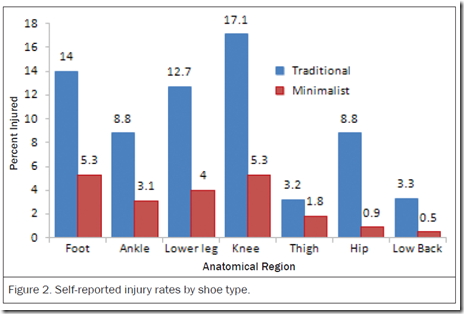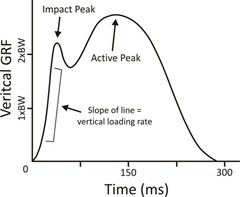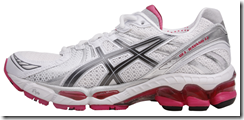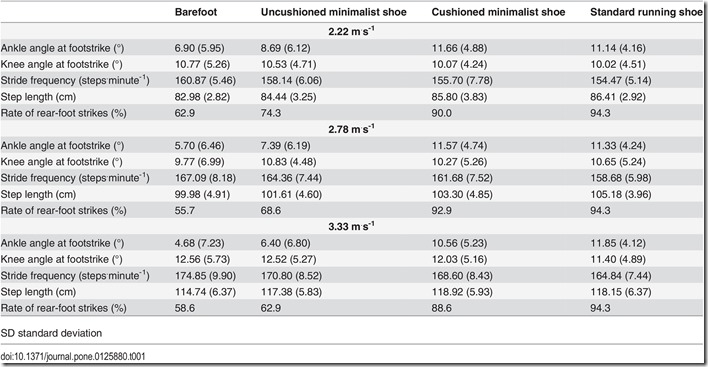Last week a flurry of articles appeared linking to the abstract of a new survey based study that suggested that traditionally shod runners are 3.41 times more likely to suffer a running-related injury than minimally shod runners. I opted to hold off on posting anything about the study until I had a chance to read the full text, which I have now done.
The study, titled “Relationships Among Self-reported Shoe Type, Footstrike Pattern, and Injury Incidence,” was authored by LTC Donald Goss of the US Army/Baylor University Doctoral Program in Physical Therapy and Dr. Michael Gross of the University of North Carolina. It will be published in the Oct/Dec issue of the Army Medical Department Journal.
Methods
The study authors crafted an internet survey and obtained responses from 2157 individual runners from Sept. 2010 to Dec. 2011. Of these, 1363 reported changing either their shoe type preference (traditional or minimalist) or foot strike in the previous year. Thus, the respondent pool was spit into two samples – 904 runners who completed the entire survey (not all did) and had not changed either shoe type or foot strike type in the previous year, and the 1363 who had made a switch in the previous year.
The specific survey question pertaining to injuries was the following:
“If an injury is defined as something that caused you to modify your training schedule for at least 1 week due to pain or discomfort (with or without formal medical care), have you experienced any lower extremity injuries in the past 12 months that you believe were caused by running?”
They followed this by asking respondents to specify the anatomical location of the injury (e.g., foot, ankle, knee, hip, etc.)
Results
Among the 904 respondents who had not switched shoe type or foot strike, 73% wore traditional running shoes, 25% wore minimal shoes (mean duration of minimalist shoe wear = 26 months), and the small remainder were primarily barefoot runners (only 16 total). Runners in the various groups were similar in mean height, age, and body mass, though minimalists were more likely to be male, had more years of running experience, and tended to report greater weekly mileage and faster training paces.
In terms of foot strike, 31% of the entire sample claimed to be heel strikers, 43% claimed to be midfoot strikers, 20% claimed to be forefoot strikers, and 6% were uncertain of their foot strike type. Barefoot and minimalist runners were more likely to self-report a midfoot or forefoot strike. The breakdown of self reported foot strike types among footwear groups looks like this:
| Foot Strike Type | |||
| Shoe Type |
Heel |
Midfoot |
Forefoot |
| Traditional | 41.4% | 45.9% | 12.7% |
| Minimalist | 5.9% | 48.5% | 45.6% |
| Barefoot | 0.0% | 60.0% | 40.0% |
Regarding injuries, runners in traditional shoes were 3.41 times more likely to report an injury than experienced minimalist runners (46.7% vs. 13.7%). As seen in the figure below from the Army Medical Department Journal, injury percentages were higher among traditionally shod runners at every anatomical location surveyed.
Comparing injury rates among foot strike groups, rearfoot strikers reported an injury incidence of 52.4%. In contrast, 34.7% of midfoot strikers reported an injury, and 22.8% of forefoot strikers reported an injury.
As mentioned above, a large proportion of the initial survey sample was excluded from the above analyses because they had either switched foot strike (n = 866) or shoe type (848) in the previous year. The vast majority of these people claimed to have moved from heel striking in traditional shoes to midfoot or forefoot striking in minimal shoes. The main reason reported for switching was a desire to overcome an injury (40-50%). The group of 397 runners who reported changing footstrike due to injury collectively reported 500 injuries, and the 372 runners who reported changing footwear due to injury collectively reported 411 injuries. It’s not specified if these injuries include those both before and after the change, so it’s difficult to conclude whether they might all be termed “transition injuries.”
Commentary
This is an interesting study for a number of reasons, but I want to state clearly at the outset that it is based on self-reported survey responses, and as such should not be confused with a prospective experimental study. In other words, we must rely on the accuracy and honesty of the survey respondents, which opens up a lot of room for debate on the value of the findings.
Regarding this, I’ll say that I am very skeptical of the self-reported foot strike percentages. To their credit, the authors openly state this as well, and have themselves conducted a pilot study showing that only about 75% of runners accurately self-report their foot strike type, and that those claiming to be midfoot or forefoot strikers are more likely to be incorrect (i.e., at least one-third who claim to land on the midfoot or forefoot are actually heel strikers).
My own research has shown that in a large sample of traditionally shod marathon runners, approximately 90% are heel strikers. A similar percentage of heel strikers was found again in a recent analysis of foot strike patterns at the Milwaukee Lakefront marathon. Thus, the self reported heel striking frequency of 41.4% for traditionally shod runners is probably a dramatic underestimate. I also have reason to suspect that the 5.9% frequency of heel striking reported by minimalist runners is also a vast underestimate (I need to publish my data on this!). Given this, my feeling is that the high likelihood of significant self-reporting error makes the comparison of injury rates by foot strike of questionable value. The authors are very clear in pointing this out themselves, and indicate that confirmation of foot strike types would make for a more compelling analysis.
In contrast to foot strike type, one would hope that experienced runners responding to a survey like this would know what kind of shoe they put on their feet. The authors did a pilot on this as well and found that 98% of runners could correctly classify their shoe as “traditional” or “minimalist,” though the detailed criteria that they used to differentiate these categories are not provided. Given the likely higher accuracy of shoe type classification, the finding that traditionally shod runners reported 3.41 times as many injuries as experienced (> 1 year) minimalist runners is interesting. One would hope that the respondents accurately reported their injuries, and most runners should be able to recall injuries that caused them to alter their training for more than a week, but it is possible that this result is tainted by enthusiastic minimalists underreporting their injuries (the authors point this out as well). This is the reason why prospective and carefully controlled and monitored studies provide more reliable results than surveys – it minimizes bias.
If we assume that the self-reports are accurate, then this study suggests that those adapted to minimalist shoes are on average at a reduced risk of injury compared to traditionally shod runners. Lots of questions, but that’s the major conclusion. However, if you consider the fact that those who transitioned their footwear or foot strike within a year of completing the survey reported an awful lot of injuries (keeping in mind that it’s not clear whether these occurred before or after the transition), the results don’t necessarily mean that minimalist is better for all. It just means that those who make it through the transition period tend to do pretty well. It could also be a reflection of some other factor – perhaps experienced minimalists get to that point because they have inherently better form or are more injury resistant and would do fine in any kind of shoe. All we can do is speculate based on the survey reports.
Transition of any type changes stress to the body, so it’s not surprising to me that injuries are more common in this period (though another study suggested that barefoot running transition injuries are actually uncommon). The big question to me is what happens to those people who get injured in transition? It would be interesting to do a follow up and see how many of those injured during transition stuck with it, and what their longer term outcomes were like. In other words, is going minimalist and/or moving to a forefoot strike a short term risk for a long term gain? I’d also love to see a before/after analysis of form and foot strike type. Though this study raises provides some interesting results, as with any scientific paper it also raises a lot of questions. My hope is that answers to these questions will continue to appear in the coming years.
What do you think, do you believe the results of this study?



















Excellent blog Peter. Very well thought-out and discussed.
Nice summary. I for one have switched to minimalist shoes in the last year, and will vehemently deny any injuries since the switch. (but it’s a total lie – I just don’t want to admit it might have been a mistake to switch!)
On the other hand, if people are reporting things like top of foot pain, which easily stops you from running for a week but is also very easily resolved with a slower transition, then the transition injury rates are overstated.
I don’t think that lie is uncommon :) But, will be interesting to see how you feel in a year.
I’m an example of someone who didn’t get injured in traditional shoes, didn’t get injured in transition, and hasn’t been injured since the switch. I did battle low-grade PF for awhile, but never altered my running in any way so it would not have been reportable in the study.
—-
Pete Larson’s Web Links:
My book: Tread Lightly – link to ow.ly
Blog: https://runblogger.com
Twitter: link to twitter.com
Facebook: link to facebook.com…
Another good point, Pete – the study doesn’t pick up on low-grade long-term problems that don’t knock you out for at least a week. I used to have a persistent problem of getting numb, tingly feet in the middle of my longer runs (it would usually go away again after a few miles). The problem was worse in some traditional shoes and better in others, but went away (almost) after I transitioned to minimalist about a year and half ago. (It’s happened once or twice since, but it’s no longer something I expect regularly.)
“The main reason reported for switching was a desire to overcome an injury (40-50%)”:
Additional problem with the study is that switching to minimalism can be associated with being more careful. This can be either a behavioral change resulting from past injuries or people who are in general careful may tend to react to injury proactively e.g. by switching shoe type more so than less careful people. In either situation, association of minimalism with carefulness would mean that it’s not necessarily minimalism that causes few injuries but the unobserved carefulness.
I suspect the switch to minimalist shoes is generally difficult and is done in order to deal with some injury. Those are two good reasons to convince yourself (and others) that the change was a good one and to downplay any subsequent injuries. That makes me reluctant to trust these figures.
I’d like to believe them, but that actually makes me even more suspicious :)
I find the opposite to be true. My running friends that refuse to acknowledge the benefits of minimalism, either out of stubbornness or because they tried it and got hurt, seem far more inclined to attack or dismiss it than the converts are to promote it. If you mention their injuries they are also quick to point out that their traditional shoes didn’t cause them, but if someone gets an injury in a minimalist shoe it’s always the shoe’s fault. I too am interested in seeing objective data from a controlled study.
The honesty of the respondents is not the main issue.
The bigger issue is that this is not a random sample
of runners. Unfortunately, this renders the results useless.
Larry Wasserman
No one wants to admit they’re heel strikers, especially if they run in minimal shoes or barefoot. I’ve found that some may not even know, or they refuse to admit it to themselves. The statistic for heel striking among minimal runners seems wrong to me, and the statistic for heel striking among barefoot runners is almost definitely wrong.
Great write up Pete!! Couple of thoughts. As you said, I think we need to take these results with a grain of salt. In my opinion you could not draw a line between foot strike type and injury for the reason you stated (self reporting is inaccurate). In regards to traditional v minimalist, you did mention the minimalist had higher mileage and faster pace, which would possibly dismiss arguments that minimalist runners are “more careful”. We also know that increased mileage is one of the very few risk factors for injury that is consistently seen in the literature, and would therefore expect to see higher injuries in the minimalist group. One factor not mentioned was previous injury history between the two groups, as previous injury does predispose to future injury. For all the studies weaknesses, I don’t think you can totally ignore the 46.7% vs. 13.7% which is a significant difference in a population of 661 traditional and 227 minimalist runners. Look forward to seeing more studies in the future!!
I still wear minimalist running shoe because it soooo light and to easy on my knee and feet. I rare have injuries because I always listen my body. If my body is tired, I get rest day. If muscle feel so stiff from long run, I take 2 to 3 rest day. I don’t do overdo my body. Just do training in right way. People will be ok with minimalist shoe if they training in right way. I don’t let media fool me about heavy or light or minimalist shoe to run with… Just let your body tell you if shoe is right for you… if not then find other shoe. I buy about 12 pair shoe every year because shoe company always change design the shoes. Yes lot money to spend on shoes because I don’t want have injuries… my body sometime not accept some shoes so I have to buy other shoe. My body hate Brooks PureConnect, it hurt my knee so bad. It still new but I throw that shoe away. Some my friend love that shoe and have no knee pain. Everybody is different and how we run, training, eat, ect… our everyday life are different. I don’t let Media fool me…. I prefer body tell me if that shoe is good or bad.
Sounds like an interesting study. Can you post the full report or provide a link?
While no one study or survey is conclusive on this topic, there does seem to be a preponderance of both scientific and anecdotal evidence pointing toward reduced injury rates from transitioning away from running with an overstride/heelstrike in traditional shoes. It certainly fits my experience and that of many of my running partners, if you factor out the superficial transition-related injuries.
I would also like to see the breakdown of results by age and number of years of running experience. I ran injury-free for many years in traditional shoes but then began to experience a never-ending string of injuries when I hit forty or so. That’s what prompted my switch to minimalist running.
The full text is not posted, but should be soon at the Army Medical Journal linked in the text above.
No surprise that you were able to dissect this study and get to the heart of the issue. I just have trouble believing any study that relies on self-reporting, especially when passions and prejudice drive the responses to a far greater degree than candid self-assessment. While the signal is strong, the utility of the study is pretty weak. Just the fact that ~60% of respondents had made a shoe-type change indicates that the survey was completed largely by those with a point to make, thus introducing a huge selection bias.
Just keep in mind that those who made a change were not part of the injury comparison – that only included experienced minimalist runners who had been in the shoes for over a year (average duration of over two years).
—-
Pete Larson’s Web Links:
My book: Tread Lightly – link to ow.ly
Blog: https://runblogger.com
Twitter: link to twitter.com
Facebook: link to facebook.com…
Oops, sorry, missed that (though I shouldn’t have). Still indicates a bit, I think, the type of respondent that the study attracted. I believe you have cited estimates of the running population that run in “minimalist” shoes previously and it was lower than 25%, yes? Though, again, I suppose that depends on the definition of minimalist shoes. I, for example, wouldn’t call the Kinvaras “minimalist”, but I guess we don’t have an indication as to whether the runners reporting in this study would have?
That’s a problem for sure – minimalist isn’t really a category in my opinion, more of a spectrum, so I don’t know what the criteria they used to define a minimalist shoe were.
—-
Pete Larson’s Web Links:
My book: Tread Lightly – link to ow.ly
Blog: https://runblogger.com
Twitter: link to twitter.com
Facebook: link to facebook.com…
These article really makes sense. I totally agree being a minimalist myself. Pointing out the main point of this post is avoid excessive tension to our feet. Too much of something is bothering when time comes.